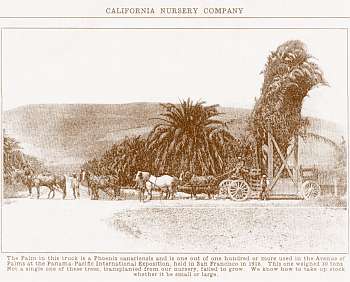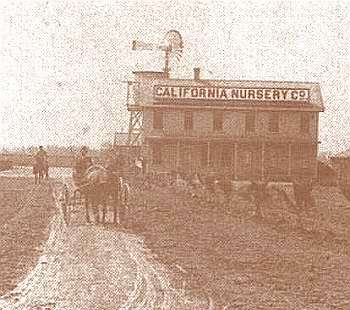California Nursery Company.
|
California Nursery Historic Park
by Nick Kirk
The California Nursery Company started in San Jose in 1865.
It was started by Johann Fels who was born at Lauterbach, Oberhessen, Germany Aug. 19th, 1836, and changed his name to John Rock once he came to America and found his way to New York at the age of 16 and secured a position in a florist’s shop.
As a young boy, when other children craved pets, this lad chose plants. He was going to have his own plant nursery.
He worked in various nurseries and a seed shop, had gradually visited important centers in several eastern states, picking up information he could.
John Rock was a self made man, having attended school only a few years during his early boyhood in Germany. Yet he spoke five different languages fluently.
He liked America, and when the Civil War broke out he joined the Union Army and became a member of the famous Duryee Zouves ( the Fifth New York Infantry).
Our patriotic young friend had won a sergeant’s stripes.
In after years, he loved to tell how he had met President Abe Lincoln and talked with him.
And, incidentally, John Rock was a member of the Military Escort at President Lincoln’s funeral.
At the close of the civil war John Rock arrived in California and worked for James Lick in Santa Clara as a gardener, Lick's garden was quite famous in this locality. (Lick’s Observatory).
John Rock had carefully saved his wages and now felt that the time had come for him to enter business.
John Rock soon started his own nursery in a small way Milpitas Road, later expanding to include a large tract of land on what is now known as Rock Ave, near Wayne Station.
Rock’s old palm trees are still growing in that area.
He became interested in the prune-trees that Pellier had introduced from France, but felt that they were not doing well as might be.
He experimented with them in his own nursery, crossing them with a certain wild plum tree, and the final results were so satisfactory that he began raising them by the thousands, finding a ready sale for them in the large orchards of this and adjacent counties.
His nursery soon became recognized as the best in the state.
This most enterprising nurseryman succeeded in introducing many varieties of fruit trees and other valuable, interesting and beautiful plants in California.
John Rock had won international recognition for his amazing success in plant propagation and was rated second only to Luther Burbank, the greatest plant wizard this world has ever known.
These two great men became close friends; it was Luther Burbank who once stated publicly: "John Rock is the most learned man in his profession to be found in California."
John Rock’s nursery in Santa Clara was growing and the need for water increased and the Coyote creek was being tapped out upstream by the growth needs of the community.
In 1884 the nursery was moved to its present location, consisting of approximately 750 acres, just north of the community of Niles.
The rich alluvial fan provided ideal soil for growing and “balling” plants.
Through riparian rights of the property bordering Alameda Creek, it was entitled to a constant source of water from the Spring Valley Water Company’s facilities in Niles Canyon.
Its proximity to the Central Pacific Railroad provided shipping facilities.
The 20th edition of the California Nursery Catalog for the season 1904-05 announced the death of John Rock in a black-bordered paragraph on page 3:
John Rock
1836 - 1904
Our beloved Manager has passed to the Great Unknown.
A familiar name and figure has gone--a man and friend of sterling qualities is no more; one in whose judgment and abilities vast numbers of people and even governments has securely rested in horticultural matters can advise no longer.
We mourn his loss!” |
William J. Landers took over the nursery operations with W.V. Eberly was the new manager.
With plenty of good soil and a rapidly expanding market, the California Nursery continued to add to its number of ornamentals, and the 50th anniversary edition of the catalog in 1915 is a good indication of the tremendous scope of the nursery’s production.
In the 1915 Panama-Pacific Exposition the nursery supplied all the Canary Island palm trees that line the Marina in San Francisco to this day, These palms were grown in Niles and were brought to S.F. on a train were they were transplanted.
Landers built the present day office around 1905.
In 1917 George C. Roeding, Sr., purchased the California Nursery Company.
He was son of Frederick C. Roeding, an immigrant from Germany who settled in San Francisco, and who, as a financier, had a great deal to do with the development of the San Joaquin Valley, Fresno in particular.
Roeding Park in that town is a monument to his desire to make the Valley more beautiful and fruitful.
A tradition avidly maintain by his son George Roeding.
The Roedings owned Francher Creek and Fresno nurseries, they supplied fruit trees by the millions and ornamentals by the thousands to landscape the orchard-homes and burgeoning agri-industry.
George Roeding was instrumental in supporting the beginnings of the fig, olive and raisin industries.
His Fruit Tree Growers Guide was the authoritative work of the times.
George was enchanted with John Rock’s California Nursery and 60 acre specimen orchard that Rock had planted.
That is one of the main reasons George Roeding bought the nursery.
The Roedings operated the California Nursery Company until it’s demise in the early 1970’s.
The old nursery was subdivided into a housing track were many of the nursery trees were incorporated in the tract design.
The once square mile nursery is now only 20 acres left, owned by the City of Fremont.
Naka Nursery and Mission Adobe Nursery lease the land from the city.
As you drive by this nursery, you can see a canopy of trees that go back to the Rock, Landers and Roeding era.
This was no doubt the greatest nursery on the pacific coast in its day.
On the next page is a day of work recorded in Dec. 1892.
Imagine how it was.
Nov. 16th 2002
|
Rock’s work day
Dec. 20, 1892
Holts with 10 men making rose cuttings
Rock with 20 men filling orders and Baling Trees
Joseph with 24 men washing and heeling in trees
(Breer) with 9 men filling order
Moffitt with 6 men filling order
10 men striping apricots and gathering stakes
Lucio with 46 men taking up Apples and Pears W Lot
7 men taking up stakes lot 2 and trees W Lot
2 men pruning Orchard lot 9 and one man catching gophers
4 teams digging trees Lot 1
4 teams digging trees Lot (1) and W Lot
3 teams plowing Lot 5 and hauling in trees
3 teams hauling in trees and hauling trees to Sta(tion)
4 horses plowing (from) trees for digger and men
2 horses plowing (from) trees for digger and men Lot 1
1 horse with Rock
received 1 car load lumber for tree boxes
received 35 sacks potatoes weight 36 (lb.)
received piece of casting for windmill
received (1/2 day files, + 3 ret. plants from F Lot)
received 1 piece pipe and half dozen hinges
received 1 bale trees from R.W. Bell Santa Rosa
received 38 pieces 2 inch pipe
Total: 175 men and 35 horses
|
|
Additional Notes:
There is some interesting literature at the time on all the benefits of plowing orchards.
The CNCo records include a LOT of plowing; Hilgards first research in California was on the merits of deep plowing.
Whether it was a good or bad thing for moisture retention is unclear, but it certainly controlled weeds and made it easier to dig and box trees if the growing roots were impacted by regular plowing.
The CNCo in the 1800's was what we would call self-sustaining, organic farming today.
Leaf mould and bone meal are used in the orchards.
In the spring the hoeing of weeds around the vegetables starts, plowing around the trees seems to go on all year.
Pest management seems to be 'one man killing gophers'.
*Brackets are around words that are hard to understand in the original script.
Information on John Rock's work schedule and the additional notes come from the Dr. Robert B. Fisher Collection at the Museum of Local History and the assistance of Jill Singleton.
|
|
|
|



